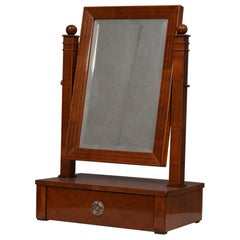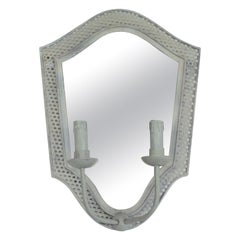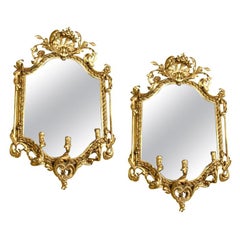Biedermeier Girandoles
to
Height
to
Width
to
1
1
1
1
1
1
1
1
1
1
1
1
1
1
1
1
1
Creator: Biedermeier
Biedermeier Cherry Wood Austrian Mirror, 1830
By Biedermeier
Located in Rome, IT
Beautiful and very special Biedermeier vanity mirror, refined and classy with a very simple design.
The mirror is formed by a structure in soft wood, which has been veneered in cher...
Category
1830s Austrian Mid-Century Modern Antique Biedermeier Girandoles
Materials
Mirror, Cherry
Related Items
1 French Mid-Century Modern Neoclassical Mirror Sconce / Girandole, M. Mategot
By Mathieu Matégot
Located in New York, NY
One large French modern neoclassical double arm metal wall light / sconce / girandole with mirrored backs in the style of Mathieu Mategot. The metal frame is pierced and the mirror h...
Category
1950s French Mid-Century Modern Vintage Biedermeier Girandoles
Materials
Metal
$2,000 / set
H 20 in W 14 in D 5 in
Rococo Style Girondole Mirrors
Located in Stamford, CT
A good pair of gilt Rococo syle girondole mirrors elaborately carved with three candle supports on each one and carved shell and foliage motifs.
Category
19th Century French Antique Biedermeier Girandoles
Materials
Giltwood
19th century English Regency Gilded Wood Convex Bull's-Eye Mirror
Located in Savannah, GA
English Regency giltwood convex mirror, circa 1810. Featuring elaborate carving at top and bottom of acanthus leaves and scrolls, with two single graceful girandole. Bull's-eye mirro...
Category
Early 19th Century English Régence Antique Biedermeier Girandoles
Materials
Mirror, Giltwood
$6,545 Sale Price
44% Off
H 33.5 in W 24 in D 7.5 in
Pair of American Eagle Gilt Carved Wood Girandole Mirrors, Circa 1800
Located in Charleston, SC
Pair of American gilt carved wood girandole mirrors with flanking eagles on rock plinths perched to flee , upper and lower acanthus carved floral motif, ebonized reeded circular mold...
Category
Early 1800s American American Colonial Antique Biedermeier Girandoles
Materials
Bronze
$60,000 / set
H 38.5 in W 24.5 in D 8 in
Pair Of Italian Red Painted Girandole Mirrors
Located in Essex, MA
Carved cartouche shaped frames with mirror plate and two arm attached candle sconce.
Category
Mid-19th Century European Rococo Revival Antique Biedermeier Girandoles
Materials
Bronze
Louis XV Giltwood Mirrored Girandoles
Located in New Orleans, LA
This incredibly rare pair of Louis XV-period giltwood mirrored girandoles capture the grandeur, grace and opulence of the Rococo movement in the decorative arts. Each opulent mirror is exquisitely framed with voluminous flourishes of naturalistic motifs exemplary of the Louis XV era’s organic, deliberately asymmetrical stylings. Holding four candles each, these outstanding mirrored girandoles would have decoratively flanked a room of the period elegantly, illuminating the giltwood lustrously and providing ambient light reflected in the mirrored glass.
Mirrors have long played an integral role in decorative design, often serving as focal points of a room. Dating back to the 13th century, the first French looking glasses were very small, yet enormously precious. Because these early mirrors...
Category
18th Century French Louis XV Antique Biedermeier Girandoles
Materials
Mirror, Giltwood
George III Style Giltwood Girandole Mirror
Located in Essex, MA
In the style of Robert Adam. Urn form finial with leaf tip swags and scrolls over an oval beveled mirror and a pair of candle arms flanked by leaves and seed pods terminating on urns...
Category
Late 19th Century English Neoclassical Antique Biedermeier Girandoles
Materials
Other
Guitar Mirror in the George II Manner
By Thomas Chippendale
Located in Sturminster Marshall, Dorset
A small carved giltwood looking glass mirror in a swirling Rococo style frame incorporating many of the mid-18th century designers repertoire of vigorous leaf carved scrolls, leaves ...
Category
21st Century and Contemporary English Chippendale Biedermeier Girandoles
Materials
Gold Leaf
Tilting Table Mirror in Brass Mid-Century Baroque Italian Design
Located in Palermo, Sicily
Tilting table mirror in brass mid-century baroque Italian design.
Category
1950s Italian Mid-Century Modern Vintage Biedermeier Girandoles
Materials
Brass
$1,782
H 20.87 in W 16.93 in D 3.94 in
Tilting Bedroom Mirror Mid-Century Italian Design Solid Brass Gold, 1950s
Located in Palermo, Sicily
Tilting bedroom mirror mid-century Italian design solid brass gold, 1950s.
Category
1950s Italian Mid-Century Modern Vintage Biedermeier Girandoles
Materials
Brass
$2,971
H 62.6 in W 18.12 in D 15.75 in
Pair Of Italian Rococo Giltwood Mirrors
Located in Essex, MA
Each with original gilded surface. Originally had a single candle arm likely in brass.
Category
Mid-18th Century Italian Rococo Antique Biedermeier Girandoles
Materials
Giltwood
Eagle Girandole Mirror in the Regency manner
By Thomas Hope
Located in Sturminster Marshall, Dorset
A carved giltwood girandole of early Regency design. The convex mirror plate is within a moulded frame decorated with gilt balls and has a carved eagle crest supported on a tapered b...
Category
21st Century and Contemporary English Regency Biedermeier Girandoles
Materials
Gold Leaf
Biedermeier girandoles for sale on 1stDibs.
Biedermeier girandoles are available for sale on 1stDibs. These distinctive items are frequently made of wood and are designed with extraordinary care. Many of the original girandoles by Biedermeier were created in the mid-century modern style in europe during the 19th century. Prices for Biedermeier girandoles can differ depending upon size, time period and other attributes — on 1stDibs, these items begin at $789 and can go as high as $789, while a piece like these, on average, fetch $789.
Questions About Biedermeier Girandoles
- 1stDibs ExpertMarch 22, 2022Biedermeier-style furniture is a type of furniture that emerged from Germany during the 19th century. The pieces were the antithesis of the opulent French designs of the time, displaying clean, simple lines and forms that emphasized functionality. Furniture in this style became popular again in the 1970s. Shop a selection of Biedermeier-style furniture on 1stDibs.
- 1stDibs ExpertSeptember 23, 2024To identify Biedermeier furniture, familiarize yourself with its characteristics. Rather than a maker, Biedermeier refers to a period in history that began in 1815 with the close of the Napoleonic Wars and lasted through 1848, when revolutions broke out in many Central European countries. Furniture produced during this era usually features simple, symmetrical designs with rounded corners and edges; cherry, walnut and birch wood were among the most common materials. During the 20th century, several manufacturers introduced lines of Biedermeier furniture inspired by 19th-century originals. If you find a marking for a 20th-century maker on your furniture, it is most likely one of these later pieces. Because it may be difficult to determine if a furnishing is an original or an example of the revival style, you may wish to have a certified appraiser or knowledgeable antique dealer help you with the identification process. Shop a collection of Biedermeier furniture on 1stDibs.
- 1stDibs ExpertOctober 7, 2024The difference between the Biedermeier and Empire styles lies largely in the characteristics most commonly associated with them. Although these two furniture styles both emerged around 1815 and persisted into the 1840s, pieces associated with them have differing features. Developed in France, the Empire style emphasized ornamentation and grandeur, with furniture makers often drawing inspiration from ancient Roman forms. Dark woods were the most commonly used materials of the style. In Germany and other parts of Central Europe, artisans working in the Biedermeier style favored simplicity. They also tended to source woods locally and chose light finishes for their pieces. Explore a selection of Biedermeier and Empire furniture on 1stDibs.


